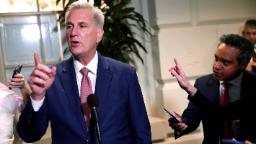[ad_1]

CNN
—
With just days to go before the government runs out of money, the Senate has unveiled a bipartisan stopgap bill in a bid to avert a shutdown – but there’s no guarantee that it will be able to pass in the House.
The release of the Senate bill, which was negotiated on a bipartisan basis, sets up a stark contrast – and a showdown – with the House, where the Republican majority faces deep divisions and the demands of hardline conservatives have been highly influential in driving the agenda as a shutdown looms.
The two chambers are now on a collision course as the House voted Tuesday night to advance a package of appropriations bill that are dead on arrival in the Senate and would not avert a government shutdown.
House Speaker Kevin McCarthy dismissed the bipartisan Senate stopgap measure, telling reporters on Tuesday night, “Let me know” when they pass that bill and saying that he had talked to Senate Republican Leader Mitch McConnell earlier in the day. McCarthy said the House will consider a separate stopgap bill with border provisions likely on Friday, regardless of whether GOP leadership is confident the votes are there to pass it.
McCarthy has little room to maneuver with only a narrow majority. Hardline conservatives have railed against the prospect of a short-term funding extension and many oppose additional aid to Ukraine, two major obstacles to finding consensus with the Senate.
The Senate stopgap bill, which would keep the government funded until November 17, includes $6.2 billion in Ukraine aid and $6 billion for natural disasters.
McCarthy told his leadership team Tuesday night that he plans to amend the Senate’s stopgap spending bill to include a House GOP border security package, according to multiple sources familiar, teeing up a massive confrontation with the Senate over immigration on the eve of the shutdown deadline.
McCarthy’s strategy, which has been echoed by Republicans all day, is to make the shutdown fight squarely centered on the issue of the border.
It is also likely that House Republicans will strip out the minimal money for Ukraine that the Senate has included in its stopgap, senior GOP sources said, given that many hardliners are opposed to it and they can’t afford many defections.
Schumer said on Tuesday as he outlined the Senate’s stopgap proposal, “We will continue to fund the government at present levels while maintaining our commitment to Ukraine’s security and humanitarian needs, while also ensuring those impacted by natural disasters across the country begin to get the resources they need.”
Now that the Senate has unveiled its own stopgap measure, the chamber will still need to pass it before it can be sent to the House and any one senator can slow passage under tight time constraints.
The Senate took an initial step to advance its bipartisan stopgap bill on Tuesday with a procedural vote of 77 to 19.
Lacking the GOP votes to pass a stopgap bill, McCarthy turned attention early in the week toward an effort to advance a series of spending bills, including for the departments of Defense and Homeland Security.
The bills would not stop a shutdown at the end of the week, but as conservatives demand the passage of full-year funding bills, McCarthy has been hoping that momentum on the measures might swing enough holdouts to support a Republican stopgap bill.
The House successfully voted Tuesday evening to pass a rule to govern debate on those bills. The vote was closely watched after McCarthy lost two procedural rule votes last week in what amounted to a major embarrassment for the House GOP leadership that underscored the deep divisions among Republicans in the chamber.
McCarthy remained insistent on Tuesday that that a government shutdown is the worst possible option and warned his conference of the perils of that strategy. “I don’t think shutdowns ever help,” he said.
A shutdown would have major impacts that would be felt across the country. If that were to happen, many government operations would come to a halt, while some services deemed “essential” would continue.
Government operations and services that continue during a shutdown are activities deemed necessary to protect public safety and national security or considered critical for other reasons. Examples of services that have continued during past shutdowns include border protection, federal law enforcement and air traffic control.
The White House on Tuesday highlighted “damaging impacts” of a shutdown that would undermine national security, pointing to the 1.3 million active-duty military members who would not be paid until the shutdown concludes and the furlough of civilian Defense Department employees.
This story and headline have been updated with additional information.
[ad_2]
